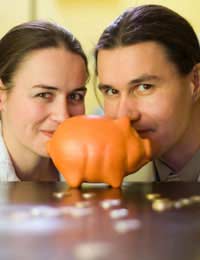Starting at age 24, Daniel can save $1,000 a month. Plan to buy a $30,000 car at age 30, get married at 29 and buy a house at age 30.
He is also repaying $150 monthly to a $48,000 study loan. Only 10 more months left to pay for a $300 motorcycle loan. The $1,000 is net saving after deducting all these debt repayment.
"How to use money after I save them ?" Daniel asked.
1. He can save in 2% fix deposit, he will have about $24,500 at age 26
2. In order to get $30,000 at age 26, his target investment return has to be 22%
3. If he didn't use the saving at age 26, it will accumulate to $76,400 at age 30 using 2% FD return
4. If he buy a car with $24,500, he will have $50,000 at age 30 using 2% FD return
So overall there is not much Daniel needs to worry about because
1. An used car of $25,000 or $30,000 are within similar range
2. Marriage may cost a few thousands typically
3. $30 to $50 thousand is enough for down payment for a typical home
Within the next 2 years, Daniel should mainly focus on cash flow control,
1. $300 motorcycle loan will end in 10 months time, by then he "should" save more every month i.e $1,300
2. He may spent only $350 for food as a student, but a working employee generally may spend more. He needs to watch that in order to achieve the $1,000 saving a month as the target he sets for himself.
3. Phone bill may increase too.
4. New spending category may also be added like entertainment, broadband, bad habits like smoking and drinking etc. Watch the friends you make, the girls you like, the bosses you kiss ass to ... make a good judgement if it is worth doing so.
1. Road Tax
2. Car Insurance
3. Petrol increase, usually by 4x from his previous motorcycle usage
4. Maintenance fee - a bad purchased used car may need frequent foreman visit
With only a target salary of $3,000 to $5,000 .... the car he will own may be his First biggest challenge.
Overall, this is the recommendation for Daniel,
2. He has 2 years before buying the used car, learn more about car mechanic, how to buy an used car, make more friends in car businesses etc. so that he can target buying an used car worth $X but he only pays $X - $Y for it. High Value for Money. Also read about
other ways to get cars.
5. Marriage is not necessary a liability, it can be a happy event that earns positive cash flow sometimes. Daniel has 5 years from now to start explore what marriage ideas that can achieve such goals.
6. Daniel has 6 years to learn about
property investment before buying his first home.


























